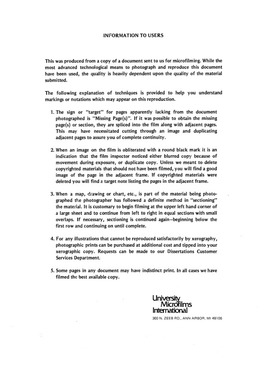| dc.contributor.author | Ajlan, Mohammad-hassan Abdul-razzag, | en_US |
| dc.date.accessioned | 2013-08-16T12:28:25Z | |
| dc.date.available | 2013-08-16T12:28:25Z | |
| dc.date.issued | 1981 | en_US |
| dc.identifier.uri | https://hdl.handle.net/11244/4909 | |
| dc.description.abstract | Conformal solution theory models for the prediction of mixture viscosity and thermal conductivity are investigated. The models predicted these properties with reasonable accuracies for wide ranges of systems and conditions. | en_US |
| dc.description.abstract | The so-called semiempirical model, set B, predicted binary mixture properties with accuracies comparable to the modified van der Waals one fluid model. The average absolute deviations of predicted binary mixture properties from experimental data by set B were (1) 3.51% for dilute gas viscosity (2.43% for nonpolar-nonpolar, 3.34% for polar-polar, 4.02% for nonpolar-polar and 3.45% for associating-associating binary pairs), (2) 10.37% for dense fluid and liquid viscosity (8.92% for nonpolar-nonpolar, 21.75% for nonpolar-polar, 13.77% for associating-associating, 17.12% for nonpolar-associating and 9.27% for polar-associating binary pairs), (3) 3.05% for dilute gas thermal conductivity (2.50% for nonpolar-nonpolar, 3.96% for nonpolar-polar and 3.10% for polar-polar binary pairs) and (4) 11.44% for dense fluid and liquid thermal conductivity (4.60% for nonpolar-nonpolar, 7.52% for nonpolar-polar, 8.00% for polar-polar, 15.15% for associating-associating, 12.43% for nonpolar-associating and 12.01% for polar-associating binary pairs). | en_US |
| dc.description.abstract | Also, an empirical model for the viscosity prediction of nonpolar mixtures is presented. This empirical model, which is not a conformal solution model, predicts the viscosity of nonpolar mixtures with average absolute deviations of 1.73% for dilute gas binary mixtures and 7.22% for dense fluid and liquid binary mixtures. | en_US |
| dc.description.abstract | The modified van der Waals one fluid model, set A, predicted binary mixture properties with average absolute deviations from experimental data of (1) 3.73% for dilute gas viscosity (1.63% for nonpolar-nonpolar, 3.28% for polar-polar, 4.75% for nonpolar-polar and 3.29% for associating-associating binary pairs), (2) 10.45% for dense fluid and liquid viscosity (9.19% for nonpolar-nonpolar, 21.21% for nonpolar-polar, 13.53% for associating-associating, 17.21% for nonpolar-associating and 7.24% for polar-associating binary pairs), (3) 3.37% for dilute gas thermal conductivity (2.68% for nonpolar-nonpolar, 3.10% for polar-polar and 4.64% for nonpolar-polar binary pairs) and (4) 11.41% for dense fluid and liquid thermal conductivity (4.73% for nonpolar-nonpolar, 8.11% for nonpolar-polar, 8.38% for polar-polar, 14.66% for associating-associating, 12.79% for nonpolar-associating and 13.47% for polar-associating binary pairs). | en_US |
| dc.description.abstract | Models developed in this work can be used for practical industrial calculations of mixture viscosity and thermal conductivity. Probably no other correlation covers such a wide range of systems and conditions with a single formulation. | en_US |
| dc.format.extent | xiv, 190 leaves : | en_US |
| dc.subject | Engineering, Chemical. | en_US |
| dc.title | Use of conformal solution models for prediction of polar, polyatomic fluid mixture transport properties. | en_US |
| dc.type | Thesis | en_US |
| dc.thesis.degree | Ph.D. | en_US |
| dc.thesis.degreeDiscipline | School of Chemical, Biological and Materials Engineering | en_US |
| dc.note | Source: Dissertation Abstracts International, Volume: 42-07, Section: B, page: 2917. | en_US |
| ou.identifier | (UMI)AAI8129425 | en_US |
| ou.group | College of Engineering::School of Chemical, Biological and Materials Engineering | |
